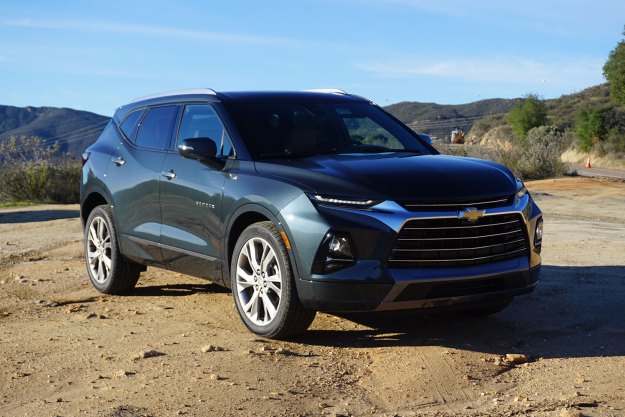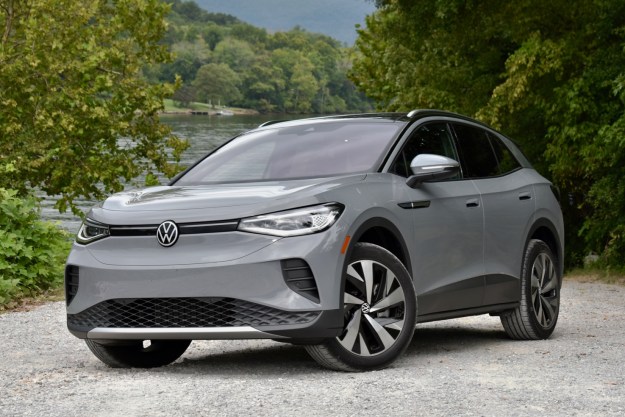
“The 2019 Chevrolet Blazer is best purchased with the high-end Premier trim.”
- Comfortable Premier trim
- Six trim levels to choose from
- Good infotainment tech
- Ample cargo space
- Worthy AWD system
- Lackluster acceleration
- RS sport trim too harsh
- Advanced safety only at high end
The history of the Chevrolet Blazer goes back to 1969, when Chevy’s engineers put an SUV body on a half-ton truck frame and gave the back half a one-piece removable top. The K5 Blazer immediately gained a devoted, some might say fanatical, following for its 4X4 capability and its simple ability to keep people and gear out of the rain. The Blazer was a fundamentally different idea than a pickup truck even though it was built on one, and both the name and the concept stuck. A smaller S10 Blazer arrived in the 1980s, but the name has been absent from Chevy’s lineup since 2005.
The all-new 2019 Blazer has been much ballyhooed, and now it’s here. This Blazer is a departure from every prior model, being a mid-size, two-row, five-passenger crossover. As such, the Blazer is aimed at families and mature buyers looking for an upscale crossover with light-duty AWD capabilities.
In traditional Chevy style, there are six trim levels to choose from, ranging from a basic front-wheel drive family wagon to a luxurious Premier model trimmed with leather and packed with tech. The most basic 2019 Chevy Blazer starts at $29,995 including all required fees, and the loaded RS and Premier models top out around $50,000, including options. That sounds expensive at the high end, but in fact it’s right in line with the competition in this segment. It’s surprisingly easy to order a $50,000 Jeep Grand Cherokee when you started ticking boxes.
Interior and exterior design
The Blazer wears an entirely new design, and it’s built on a different platform than any of its ancestors. Chevy went out of its way to make a bold statement with the exterior, incorporating the floating roof treatment that’s been popular across the industry lately. The Blazer has a prominent nose and a big grille. Provocative cutlines emphasize the body sculpture. The overall effect of the exterior design suggests performance, especially in the distinct RS sport trim. We think it’s one of the sportiest-looking models in its segment.
The Blazer is over a foot shorter than its mid-size Chevy Traverse stablemate. The Blazer offers 64.2 cubic feet of cargo capacity with the rear seats down, compared to 98.2 cubic feet in the Traverse. It’s clear that the Blazer relates to the Traverse the way the Tahoe relates to the Suburban in the full-size segment. Tahoe is one of Chevy’s most successful models, so we’re not surprised it held to the formula.
There’s a point to the Blazer’s design. Eliminating the possibility of a third row of seats enables designers to offer more interior space, including up to 39.6 inches of rear legroom. Passengers can move the second-row seats forward and back a bit, and they can recline a little. So, the Blazer can be much more comfortable for second row passengers without getting too long to be nimble.
The Premier trim’s seats are delightfully comfortable, and available with heat and ventilation for year-round comfort.
The cabin treatment on the Blazer is much the same as other SUVs in the category. You won’t find artisanal wood trim or other superfluities, but it’s well-made and comes with the features that family buyers care about. The base trim seats are good, not the backbreaking torture devices you find in some base models. At the high end, the luxury Premier trim seats are delightfully comfortable and optionally equipped with heat and ventilation for year-round comfort. The same option pack that puts heat and air in the front seats puts heat into the outboard rear seats as well.
If you test-drive the RS trim, you might find the included sport seats problematic. They’re quite firm, and in fact firmer than we’d want to live with on a long-distance drive. If you’re considering the RS, be sure to include some rough pavement in your drive before you make your decision.
Tech features
You can load the new Blazer up with all the tech you can think of, but only at the highest trim levels. Navigation, for example, is included only on the top RS and Premier trims. Even then, adaptive cruise control, wireless device charging, and the rear camera mirror are available only through an additional option pack. The top Premier trim comes with the Bose audio system, and it’s optional in the RS trim.

Chevy is a bit more democratic with the basic infotainment system. All Blazer models have an 8.0-inch touchscreen mounted high on the dash, with a few key buttons and a volume knob placed just below. The Blazer includes GM’s usual 4G/LTE Wi-Fi hotspot capability, and the system supports Chevy’s Infotainment 3 operating system, plus Android Auto and Apple CarPlay. So right from the base trim you’ve got access to navigation and data services through your phone. The base trims also include a 4.2-inch driver information center display, and that grows to 8.0 inches in the RS and Premier trims.
Driving impressions
The Blazer comes with two engine options. The two low-end Blazer trims offer a direct-injected, 2.5-liter four-cylinder engine rated at 193 horsepower and 188 pound-feet of torque. This engine is paired with a nine-speed automatic transmission, and is offered only in front-wheel drive configuration. Fuel economy is good for the class, running at an EPA-estimated 22 MPG city and 27 MPG highway, with a 24 MPG average. Chevrolet didn’t bring any of these Blazers for us to drive, so actual on-road performance remains a mystery.
The 2019 Chevrolet Blazer is an appropriate re-imagining of the Blazer tradition for the modern world.
Starting with the mid-grade Blazer V6 trim, buyers get a 3.6-liter V6 rated at 308 hp and 270 lb-ft. of torque. All V6 Blazers are paired with a nine-speed automatic transmission with the buyer’s choice of front-wheel drive or all-wheel drive. When equipped with the former the V6 returns 20 MPG city, 26 MPG highway, and 22 MPG combined. If you opt for the latter, you can expect 18 MPG city, 25 MPG highway, and 21 MPG combined. We did a bit better than that on the test drive, achieving an average of up to 26 MPG with front-wheel drive. Acceleration with the V6 is adequate, but not outstanding. There’s power to make a pass, but with over 300 horsepower and nine gears to work with, we expected a little more muscle than the Blazer showed us.
A point worth noting is that there are two different AWD systems available with the Blazer V6, depending on the trim level you choose. The mid-level Blazer V6 Cloth and Blazer V6 Leather trims feature an AWD system with a single clutch that can engage or disengage the rear axle as needed. The top RS and Premier trims offer a dual-clutch AWD system that can automatically engage either of the rear wheels as needed. This feature offers improved traction on ice, snow, or mud, and improves handling on dry pavement. We don’t expect it will keep up with a Grand Cherokee on the trail, the Jeep remains the uncontested off-road leader in this segment, but it will get you and yours home through a blizzard.

Another feature to mention is that all Blazers feature driving modes that control transmission and stability control behavior. Blazers equipped with front-wheel drive offer a selection of Normal, Snow/Ice, or Sport modes. In Blazers equipped with all-wheel drive, the range of driving modes includes FWD Touring, AWD, Sport, Off-Road, and Tow-Haul mode, if equipped.
The Blazer has distinctly different personalities based on the trim level. The Blazer RS comes with sport-tuned dampers that are a little firmer than the other trims, and a quicker steering ratio. In fact, we found the RS to be a little too stiff for comfort. It’s Chevrolet’s answer to the Ford Edge ST, which packs more power but doesn’t steer as well. Of course, if it’s all-out performance you’re after in this segment, it doesn’t get any better than the 707-hp Jeep Grand Cherokee Trackhawk.
The Premier is a smoother experience, and markedly more comfortable than the RS while still offering flat and responsive cornering. You’ll never find any Blazer wallowing in a corner under normal driving conditions.
Rivals
The Blazer competes with three well-established vehicles. The first two are the 2019 Ford Edge and the 2019 Nissan Murano. Nissan tends to be low-price leader in this group, albeit only by a few thousand dollars when the vehicles are comparably equipped. The Ford Edge offers a high performance ST trim that competes directly with the Blazer RS.
The 800-pound gorilla of the two-row, mid-size SUV market is the 2019 Jeep Grand Cherokee.
However, the 800-pound gorilla of the two-row mid-size SUV market is the 2019 Jeep Grand Cherokee. This model sold almost 225,000 units last year, far outstripping any rival. Leaving aside high priced performance models like the SRTand Trackhawk, the Grand Cherokee is competitive on price and features when matched against Blazer, and offers a more capable dual-range 4WD system. The Jeep will be Blazer’s most cross-shopped vehicle and the toughest to beat.
Peace of mind
Chevrolet offers a three-year, 36,000-mile bumper-to-bumper warranty on the 2019 Blazer, and coverage on the powertrain is five years or 60,000 miles.
All Blazers come equipped with basic safety features, plus OnStar, teen driver tools, LED daytime running lights, and a government-mandated rear-view camera. The basic trim levels can be upgraded with a Driver Confidence package that includes blind spot and rear cross traffic monitors, lane change alert, and rear parking proximity alert.
However, you have to buy the top RS or Premier trims and an option package if you want the full suite of the latest safety features. Automatic forward emergency braking with pedestrian detection, following distance indicator with forward collision alert, lane-keeping assist, and a 360-degree surround camera system are all part of the Driver Confidence II package. You have to pay extra to get them, which pushes the price of a fully-equipped Blazer up towards $50,000.
How DT would configure this car
If we were shopping for a Blazer of our own, we’d bite the bullet and go straight to the Premier trim, and add the relevant option packages. This is where the Blazer really comes together, and it’s the only way to get the advanced driver assistance and convenience features. We found the RS trim good looking, but the ride was too harsh for everyday driving. At first glance, the nearly $50,000 price tag on the Blazer Premier with the Driver Confidence II package seems high, but as we cross-shopped the competition we found that it’s in line with the other brands. If you want a well-equipped mid-size SUV, that’s the ticket price.
Conclusion
The 2019 Chevrolet Blazer is an appropriate update of the Blazer tradition for the modern world. Buyers who enjoyed the compact S10 Blazer back in the 1990s are likely to be ready for a mid-size luxury today, and they’ll appreciate what the new Blazer brings to the market.
Editors' Recommendations
- Bold style alone can’t muscle Chevy’s new Blazer EV to the head of its class
- Mercedes-Benz EQE SUV first drive review: ’90s look, cutting-edge tech
- 2022 Mercedes-Benz EQB first drive review: An EV better than its gas sibling
- 2023 Kia Sportage Hybrid first drive review: Style and substance
- Jeep Grand Cherokee 4xe first drive review: Do-it-all plug-in






